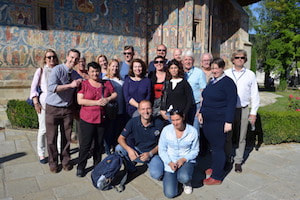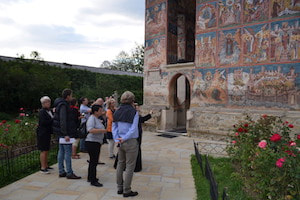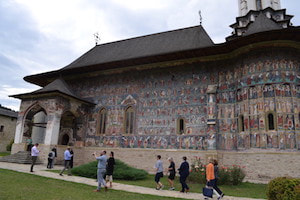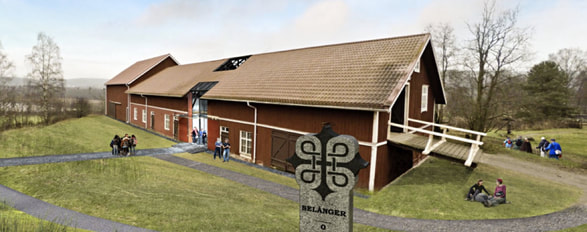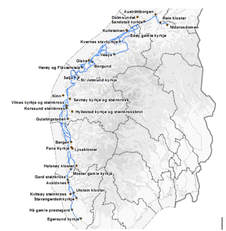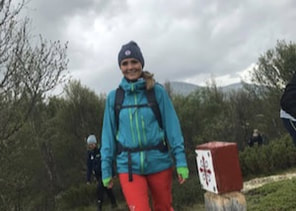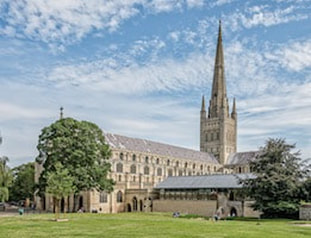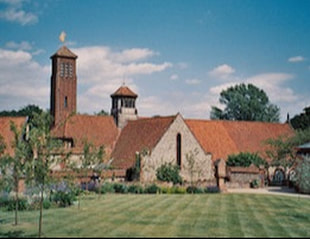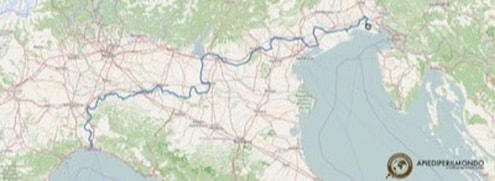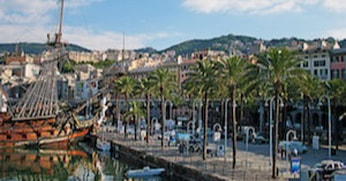European Green Pilgrimage Network Winter 2017 newsletter
|
EGPN members visit Romania as part of a Green Pilgrimage Interreg Europe study trip
|
Members of the Green Pilgrimage Interreg Europe Project visited Romania in September on a study trip aimed at sharing experiences and best practices. And members certainly had plenty to ponder after the five-day trip which highlighted Romania's rich relationship between heritage, culture and faith.
The study visit was part of the five-year, €1.18 million Green Pilgrimage Interreg Europe Project which brings together six regions in England, Italy, Norway, Sweden and Romania to promote green pilgrimage. Participants learned about the importance of tourism and the development of cycling routes and pedestrian trails in Bucovina, particularly around the area's famous painted monasteries (pictured above), several of which are UNESCO World Heritage sites. His Eminence Damaschin Dorneanul, Archbishop of Suceava and Radauti, gave an overview of the history of religious pilgrimage in Romania (which includes Orthodox and Catholic faiths). Field trips included visits to St John, Suceviţa and Moldoviţa Monasteries (all UNESCO sites) as well as the black pottery centres of Marginea and Rădăuți, and participants also had the chance to take part in a walking pilgrimage. |
EGPN member Rev Berit Lanke gave a presentation on her experience of the different approaches to pilgrimage between Catholic, Anglican and Orthodox churches and her own Lutheran tradition.
As someone who 'could not envisage a pilgrimage without a long route to walk', on joining an Orthodox pilgrimage in Bulgaria, she was very surprised to find that everyone arrived by car. 'The only pilgrimage by foot was a few metres' liturgical procession down the hill to the gate of the monastery.' But, finding herself standing all night in the church, she realised 'the big achievement here was not me walking far across mountains with my backpack but it was a holy moment of encounter with the Holy God and Saviour, the holy Saint and Saints.' You can access her presentation here. |
News from St Albans, UK: Thousands of pilgrims gather for this year's Alban Pilgrimage
|
Every year a spectacular procession of puppets takes to the streets for St Albans Cathedral’s Alban Pilgrimage – a unique event which tells the remarkable story of Alban, Britain’s first saint.
This year's Pilgrimage took place on June 24 and welcomed the first woman diocesan Bishop, the Rt Revd Rachel Treweek, and the Dean of Christ Church, Oxford, the Very Revd Prof Martyn Percy as guest preachers. Attracting thousands of pilgrims and spectators, the weekend was a wonderful celebration of the city’s namesake. St Alban died on June 22, over 1700 years ago. He was executed for giving shelter to a Christian priest, Amphibalus, who was fleeing persecution by the Romans. Moved by the priest's faith, Alban became a Christian and the two men swapped cloaks, enabling the priest to escape. Alban was arrested instead and executed on the hill where St Albans Cathedral now stands. As well as being an important part of the Cathedral's |
history, the story of St Alban and St Amphibalus are integral to our Heritage Lottery funded project, Alban, Britain’s First Saint: Telling the Whole Story.
The project will enable us to refresh the story of Alban within the Cathedral, home to the saint’s Shrine, and enable the Cathedral to continue its legacy of welcoming pilgrims and tourists alike. Looking ahead to 2018:
Further information on the pilgrimages and the ABFS project will be on our website in the New Year: www.stalbanscathedral.org. |
News from Norway: Collaboration across borders and St Olav's Way developments
The St Olav Way inspires sustainable development to cater for pilgrimsThere is great potential for sustainable development along the St Olav Way, especially on its eastern route from Sundsvall in Sweden to Stiklestad in Norway and Nidaros Cathedral in Trondheim. Small and medium sized entreprises (SMEs) on both sides of the border are combining their strengths to create a chain of eco-friendly industries to enhance the pilgrims' experience.
A culture and pilgrim centre is being built at Selånger in Sundsvall that for many will be a milestone on their pilgrimage to Nidaros Cathedral from Russia, Finland and Sweden. For others it will be a starting point on a pilgrimage from Sundsvall to Nidaros Cathedral. Such is the enthusiasm that a recent gathering of SMEs was held to spur collaboration across the border. As well as showcasing success stories, there were debates about the future expansion of eco friendly and sustainable solutions, the development of local produce, tips on marketing through the local press and how to maintain the authenticity of a pilgrimage. |
A new coastal pilgrim routeAfter a five-year project to create a coastal pilgrim route from Egersund in the South of Norway to Nidaros Cathedral in Trondheim, the collaborating County Councils along the coast have formally submitted an application to the National Pilgrim Centre to be acknowledged as an official part of the St Olav Ways. The decision is expected to be made official around Easter 2018. The Coastal Route brings a whole new element to pilgrimage in Norway, basing its travel by boat and not by foot, though there are stretches along the route that also cover land.
|
Minister of Culture on pilgrimageNorway's Minister of Culture Linda Hofstad Helleland (pictured above) invited key representatives of faith groups, volunteer organisations, tourism and industry to join her on a pilgrimage from Oslo to Trondheim this summer. The pilgrimage included walks, talks, concerts, food and meetings with local communities. Afterwards the Minister announced that she intends to review the National Pilgrimage Development Strategy. Her aim is to strengthen political support for culture and cultural heritage, with a strong emphasis on sustainable development and mutual collaboration between faiths, organisations and industry. The review is expected to be launched early 2018.
|
Plans to strengthen St Olav Path through Sweden and NorwayThe St Olav Path (St Olavsleden) is one of the St Olav Ways leading to Trondheim. The 565km path goes from coast to coast through both Sweden and Norway and is the second most popular path for pilgrims walking to Trondheim and Nidaros Cathedral.
Now Nidaros Pilgrim Centre, the Stiklestad Pilgrim Centre (both in Norway) and the congregation of Selånger in Sweden are joining forces to apply for an Interreg EU-funded project. Selånger marks the start of this path, and is now building a brand new pilgrim centre (pictured above). The aim is to build closer links between these three key points on this pilgrim path, and to further strengthen bonds across the border. We also want to collect and document more of the historic knowledge as well as better communicate all the interesting cultural heritage and natural features along the way. Norway has the benefit of a strong network in the shape of the public/state programme for The St Olav Ways, with the National Pilgrim Centre as the lead coordinator. Both Nidaros Pilgrim Centre and Stiklestad Pilgrim Centre are part of this network and we hope that the years of working with the St Olav Ways has given us knowledge and experience that this new partnership can benefit from. The plan is to submit the application in February, so we are working intensively on all the details. To be continued! |
News from Norwich: Developing a safe walking pilgrimage to the Walsingham shrines
|
Norwich Cathedral in the UK is working to re-establish a safe and attractive walking pilgrimage route between Norwich and the Shrines of Our Lady of Walsingham as part of a broader ambition to develop a network of recognised historic routes to Walsingham.
Pilgrims have been coming to Walsingham since 1061 and today the Shrines (Anglican and Roman Catholic, with significant Methodist and Orthodox centres) attract some 300,000 visitors each year to this small and remote village. Almost all travel by coach and car. While the environmental impact on an ancient natural and architectural environment is significant, pilgrims tend to spend little outside the shrines and in the community. Bringing foot pilgrims to Walsingham would broaden the demographic profile of pilgrims and boost the local economy. Where pilgrimage routes have been re-established in Britain, organisers have sensibly tended to stitch together existing public footpaths. In this case, no such rights of way survive: the route is almost entirely on metalled roads. The first order of business, therefore, is to commission a survey of land ownership along the route and to seek agreements to establish permissive road-side or cross-country routes. We are applying for funding to allow this survey to go forward. In addition, we are seeking to build working partnerships with parish churches, community councils, and local businesses to help create an infrastructure to support the needs of pilgrims on the route. We are also building up partnerships with local nature, conservation, and heritage bodies to establish a broadly based community of interest to support this development. In addition, Norfolk County Council is working with the Shrines and other local interests in Walsingham to ‘green’ the present pattern of pilgrimage. |
News from Italy: After a year of painting yellow arrows, a new pilgrimage route opens
|
After four years of study and a year of painting yellow arrows along 931 km in Northern Italy, the Via Postumia has launched as a new path in the network of St James Routes.
The Via Postumia's route connects nine World Heritage sites as it crosses from East to West in Northern Italy on an ancient consular route long used by pilgrims to Jerusalem and Santiago. Conceived by Postumius Albino for military purposes, its origins date to 147 BC. The project to reopen the long forgotten route started in September 2013 when Andrea Vitiello was attending the World Meeting of Associations of Saint James in Krakaw, Poland. 'Listening to the work of the various World Associations, and in particular European Associations, I realised that in the map of European routes towards Santiago de Compostela, Italy was missing, ie, missing a path marked with yellow arrows that cut our country from East to West.' He started by studying the ancient |
routes and 'thanks to the advice and opinions of scholars and pilgrims, I began to recreate the steps of medieval pilgrims from the East', he explained.
The Via Postumia's modern itinerary is based on the Itinerarium Burdigalense diaries. Starting at Aquileia on the Adriatic Sea and ending in Genoa on the Ligurian Sea, the route spans 930 km in 40 stages. From Aquileia to Piacenza, the itinerary follows secondary roads and cycling paths in fairly uninspiring terrain, but the route passes through cities of art such as Aquileia, Palmanova, Treviso, Vicenza, Verona and others. After Piacenza, the route becomes more uneven and the landscape opens to spectacular views and is feasible by bicycle. More information, including a guide to accommodation, is available (in Italian) from the website: http://viapostumia.eu, with some English language information available here. |


